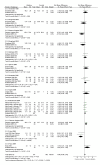Causal assessment of dietary acid load and bone disease: a systematic review & meta-analysis applying Hill's epidemiologic criteria for causality
- PMID: 21529374
- PMCID: PMC3114717
- DOI: 10.1186/1475-2891-10-41
Causal assessment of dietary acid load and bone disease: a systematic review & meta-analysis applying Hill's epidemiologic criteria for causality
Abstract
Background: Modern diets have been suggested to increase systemic acid load and net acid excretion. In response, alkaline diets and products are marketed to avoid or counteract this acid, help the body regulate its pH to prevent and cure disease. The objective of this systematic review was to evaluate causal relationships between dietary acid load and osteoporosis using Hill's criteria.
Methods: Systematic review and meta-analysis. We systematically searched published literature for randomized intervention trials, prospective cohort studies, and meta-analyses of the acid-ash or acid-base diet hypothesis with bone-related outcomes, in which the diet acid load was altered, or an alkaline diet or alkaline salts were provided, to healthy human adults. Cellular mechanism studies were also systematically examined.
Results: Fifty-five of 238 studies met the inclusion criteria: 22 randomized interventions, 2 meta-analyses, and 11 prospective observational studies of bone health outcomes including: urine calcium excretion, calcium balance or retention, changes of bone mineral density, or fractures, among healthy adults in which acid and/or alkaline intakes were manipulated or observed through foods or supplements; and 19 in vitro cell studies which examined the hypothesized mechanism. Urine calcium excretion rates were consistent with osteoporosis development; however calcium balance studies did not demonstrate loss of whole body calcium with higher net acid excretion. Several weaknesses regarding the acid-ash hypothesis were uncovered: No intervention studies provided direct evidence of osteoporosis progression (fragility fractures, or bone strength as measured using biopsy). The supporting prospective cohort studies were not controlled regarding important osteoporosis risk factors including: weight loss during follow-up, family history of osteoporosis, baseline bone mineral density, and estrogen status. No study revealed a biologic mechanism functioning at physiological pH. Finally, randomized studies did not provide evidence for an adverse role of phosphate, milk, and grain foods in osteoporosis.
Conclusions: A causal association between dietary acid load and osteoporotic bone disease is not supported by evidence and there is no evidence that an alkaline diet is protective of bone health.
Figures







References
-
- Energize for Life. http://www.energiseforlife.com/cat--Alkalising-Supplements--ALKALISING_S...
-
- Acid-2-Alkaline. http://www.alkalinebodybalance.com/
-
- Beginning an Alkaline Diet. http://ezinearticles.com/?Beginning-an-Alkaline-Diet:-The-Basic-Principl...
-
- Alkaline Diet Guy: Alkaline Food or Acid Food-Why should I care? http://www.kewego.co.uk/video/iLyROoafMHPI.html
-
- Brown SE. Better bones, Better body. 2. Columbus: McGraw Hill; 2000.
Publication types
MeSH terms
Substances
LinkOut - more resources
Full Text Sources
Medical
Research Materials
Miscellaneous

